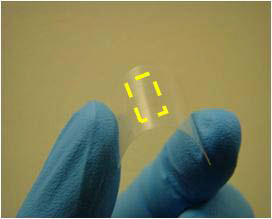A group of researchers from the University of Southern California has prepared flexible and transparent layers based on carbon atoms that have a high potential to be used as an innovative type of solar cells

A group of researchers from the University of Southern California has prepared flexible and transparent layers based on carbon atoms that have a high potential to be used as an innovative type of solar cells.
"Organic photovoltaic cells (OPV) are presented as a means of saving energy thanks to their simplicity of production, their light weight and their high compatibility with flexible materials," wrote Chongwu Zhou, a professor of electronic engineering at the University of Southern California, in an article published in the scientific journal ACS Nano. The method described in the article constitutes real progress towards an innovative design of cells of this type that have significant advantages, especially in the aspect of physical flexibility.
An essential component of any OPV type photoelectronic device is a transparent conductive electrode through which light is able to react with active materials to obtain electricity. The new research suggests that graphene, a highly conductive and transparent form of carbon, made up of single-atom-thick carbon layers, has considerable potential to serve in this role. Despite the fact that the existence of graphene has been known for decades, its vigorous research only began in 2004, due to the difficulty of producing it in quality and in large quantities.
Researchers in Zhou's laboratory reported three years ago on the production of graphene layers on a large scale using a method known as "chemical vapor deposition" (CVD). Using this method, the team of scientists was able to prepare extremely thin graphene layers by initial deposition of carbon atoms in the form of graphene layers on a nickel surface from methane gas.
In the next step, they placed a thermoplastic protective layer over the graphene layer, then dissolved the lower nickel layer with an acidic liquid. In the final step, they attached the graphene layer protected by plastic to a flexible polymer sheet, then integrated it inside an OPV cell. The research team was able to produce graphene/polymer layers that extend up to an area of 150 cmXNUMX, and these can be used to obtain dense arrays of flexible OPV cells.
OPV cells convert solar radiation into electricity, but their efficiency is less than that of silicon (silicon) cells. The energy generated by sunlight on a clear and hot day is about a thousand watts per square meter. "From every thousand watts of solar radiation hitting the area of a square meter of a Zoran-based solar cell, 14 watts of electricity are obtained," explains one of the researchers. "Organic solar cells are less efficient; Their conversion efficiency for those thousand watts of solar radiation in graphene-based cells will result in receiving only 1.3 watts."
However, graphene-based OPV cells compensate, even more, for their lack of efficiency through lower cost and higher physical flexibility. The researchers believe that eventually it will be possible to produce extensive surfaces coated with solar cells of this type, similar to the production of newspaper rolls by printing presses.
"It will be possible to hang these surfaces as curtains in houses or even produce fibers from them that will be used as electricity-generating clothing. I can imagine people powering their phones or portable music/video devices while running on a sunny day,” he adds.
The researchers claim that their new cells should have at least one significant advantage over the competing design of OPV cells based on Indium-Tin-Oxide (ITO). In experiments conducted in their laboratory, the researchers claim, ITO cells failed after bending at a small angle, while their cells remained active even after repeated bending at larger stretching angles. This finding will give graphene-based solar cells a decisive advantage in several applications, including "printed" fabrics, as the researchers suggested.
The article concludes and claims that the innovative approach is a significant advance towards the production of transparent conductive electrodes in solar cells. "Chemical vapor deposition of graphene meets most of the important conditions required to replace indium-tin oxide in organic photovoltaic components, including: high distribution, low cost, conductivity, stability, compatibility with organic components and physical flexibility, which should lead to the development of important applications in organic optoelectronic devices future."

5 תגובות
Lennon asked if they would rest a few layers. The islands will receive more watts per square meter.
There are a number of companies in the world that already produce OPV cells, and from what I know their utilization is 3-5% in field conditions (silicon panels use 13-16% in field conditions), the companies already produce the cells in a printing configuration (as indicated "printing presses") in mass production .
The panel is transparent with red/green/blue stripes that you can see through (like XNUMXD glasses).
And you can bend them so that a 20 cm panel can touch end to end without "breaking", an experiment has already been conducted for cells that are "printed" on textiles (with the American army).
As part of my work, I have a number of such transparent cells at home from one of the companies, and I must say that it is amazing.
An efficiency of 1.4 percent in silicon and 0.13 percent in graphene? run issue…
What is the enthusiasm? Is it heavy to spread the boards? Still 0.13 percent
I don't know such a company, although that doesn't mean there isn't one. In the meantime, anyway, most of the developments are done in the academy.
Really unexpected, another article about graphene.
With all these articles and studies about "graphene" it seems to me that we should start investing in companies dealing with graphene.
You need to talk to the broker urgently.